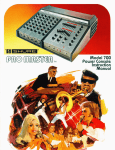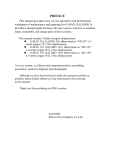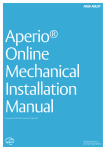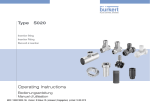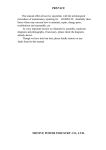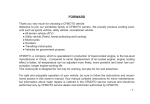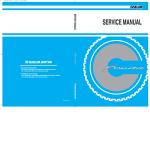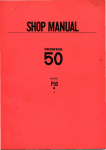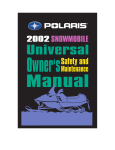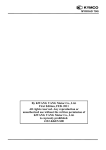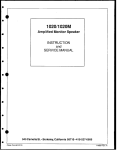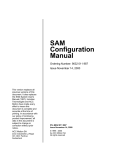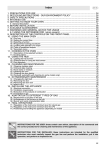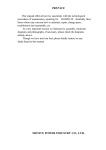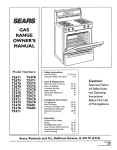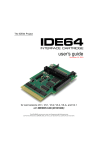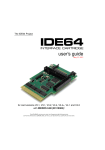Download TR3-50 SERVICE MANUAL
Transcript
TR3-50 SERVICE MANUAL Manufactured by PGO of Motive Power Industry Co., Ltd 1 PREFACE This manual provides every service specialist with professional techniques of maintenance and repairing for Tricycle T-REX 50. It provides a detailed guide for those who may concern with how to maintain, repair, reassemble, and change parts of their scooters. At every section, we illstrate each important point by assembling procedures, explosive diagrams and photographs. Although we have tried our best to make this manual as perfect as possible, please kindly inform us if any fault needs to be corrected in this manual. Thank you for purchasing our PGO scooters. Motive Power Industry Co., Ltd. Service Department October 20, 2004 2 CONTENTS: Page Ⅰ.The specification of T-REX 50 Ⅱ.Service information (1)The operation notice (2)Locking torque value (3)Lubrication instruction (4)Wiring diagram (5)Troubleshooting Ⅲ.Checking and adjustment (1)Regular checking table (2)Battery (3)Cleaning air cleaner (4)The final reduction mechanism oil (5)Spark plug (6)Compression pressure measurement (7)Ignition timing (8)Throttle cables adjustment (9)Idle adjustment (10)Front brake adjustment (11)Rear brake adjustment (12)Tire Ⅳ.Dismantling, maintaining, repairing and assembling operation (1)Lubrication system (2)Plastic parts (3)Engine dismantling (4)Drive pulley, starter, clutch (5)Cylinder and piston (6)AC generator (7)Final transmission mechanism (8)Crankcase, crank shaft (9)Carburetor, reed valve, auto cock (10)Steering column, front wheel, front brake comp, front fork (11)Rear wheel, rear brake, rear damper (12)Fuel tank, oil tank (13)Reverse Differential gear comp 3 Ⅴ.Electric equipment (1)Troubleshooting (2)Battery (3)Recharge system (4)Ignition system (5)Starting system 4 SPECIFICATIONS Model Overall Length Overall width Overall height Seat height Wheelbase Dry weight Engine Model Piston displacement Bore Stroke Compression ratio Ignition Clutch Shifting Lubricant Steering angel Left Right Transmission TR3-50 1930mm 880mm Primary reduction Direct 52/13*44/13 Secondary ratio 1145mm 770mm 1385mm 133kgs P2 49CC 40.0mm 39.2mm 6.8:1 CDI Centrifugal / CVT Drive / Reverse Auto seperated 、 41 41 5 110CC Reverse differential Frame Front fork Rear cushion Front tire Rear tire Fuel Capacity Drive/Reverse 250CC Steel pipe Telescopic Uni-absorber 120/70-12*1 130/70-12*2 Unleaded gas Front brake 6.7L Hydraulic disk brake Rear brake Durm brake Head light Tail light Signal light Silencer 12V-18W*2 12V-10W/3W 12V-10W*4 Diffusible absorption Ⅱ.Service information: (1)The operation notice (2)Locking torque value 1.For engine 2. For chassis 3. Others (3) Lubrication instruction a.For engine b. For chassis c. Wheel bearing (4)Wiring diagram (5)Troubleshooting 1.Difficult starting or starting 2.Weak acceleration 3.Engine running not smoothly (low speed) 4.Engine running not smoothly(high speed) 5.Clutch, drive & driven pulley 6.Handlebar steering was astray when running 7.Front and rear damper not balanced 8.Brake disorder 9.Oil indicator malfunction 10. Fuel indicafor malfunction 11. starting motor malfunction 12.No sparking 13.Charging abnormal 6 (1)The operation notice: 1.For parts like the gasket, o-ring, clips and circlets, please change a new part whenever re-assembled. 2.When trying to tighten screws or nuts, please lock tightly according to each recommended locking torque and in the sequence of the”X” pattern. 3.Please use PGO or PGO recommended parts. 4.After dismantling, please clean all parts involved or used for checking and grease all contact surfaces when reassembling. 5.Use grease recommended by P.G.O. 6.When removing the battery, please disconnect the negative pole(-) first. However, please connect the positive pole(+) first when assembling. 7.Before installing a new fuse, please be sure that the specification is correct. 8.After reassembling, please re-confirm that all connecting point, locking parts, circuits, polar characteristics are functioning well befor selling out. 7 Operation Notice: 1.Turn the shifting bar to right side to drive backward. 2.Turn the shifting bar to left side to drive forward. CAUTION:Don’t shift the gear until the vehicle is stopped. When shifting to “R”, you have to brake the vehicle simultaneously, otherwise the engine will stop automatically for your safety. 3.Use the brake-lock device in the LH switch comp when stopping in inclined road. 8 (2) Locking Torque Value: 1.Engine No 1 2 3 4 5 6 7 8 9 10 11 12 13 14 15 16 17 18 19 20 Locking location Cylinder head Flywheel outer Rear brake lever Driving pulley Clutch outer Right crankcase Drive gear box cover Left crankcase Draining and filler bolt Inlet pipe Flywheel magneto stator Cooling fan Muffler nut on cylinder head Starting motor Bracket between eng. and Rubber pad of central stand Spark plug Fan cover Fixed plate, drive clutch Nut of rear wheel axle Kick starter Locking Dia (mm) torque kg-m 7 1.0~1.4 10 3.2~4.0 6 1.0~1.2 10 3.2~4.0 10 3.5~4.0 6 1.0~1.2 6 1.0~1.2 6 1.0~1.2 8 1.8 6 1.0~1.2 6 1.0~1.2 6 1.0~1.2 6 1.0~1.2 6 1.0~1.4 6 1.0~1.2 Thread Remarks When the engine is cold When the engine is cold When the engine is cold When the engine is cold 14 6 6 14 6 2.5~3.0 1.0~1.2 1.0~1.4 11~13 1.0~1.2 10mm 12mm 12mm 3.0~4.0 5.0~6.0 5.0~6.0 Lock nut (U type nut) (U type nut) 10mm 8mm 8mm 3.0~4.0 2.0~3.0 2.0~3.0 Lock nut 8mm 2.0~3.0 Lock U TYPE NUT 2. chassis 1 2 3 4 5 6 Steering stem nut Front axle nut Fixed nut fasten eng. and chassis Rear shock absorber(upper) Rear shock absorber(lower) Lock nut faster frt. brake disk and frt. wheel rim Lock bolt between frt. brake pump and frt. absorber 9 3.Other parts standard torque values: No Item 1 2 3 4 5 6 7 8 9 10 11 Torque kg-m 5mm bolt and nut 6mm bolt and nut 8mm bolt and nut 10mm bolt and nut 12mm bolt and nut 5mm screw 6mm screw 6mm flange bolt and screw 7mm flange bolt and screw 8mm flange bolt and screw 10mm flange bolt and screw 10 0.45-0.6 0.8-1.2 1.8-2.5 3.0-4.0 5.0-6.0 0.35-0.5 0.7-1.4 1.0-1.4 1.0-1.4 2.0-3.0 3.0-4.0 (3)Lubrication instruction A. Engine NO Lubrication location 1 Crankcase:rotating part, Sliding part 2 Cylinder:rotating part, Sliding part. 3 Drive gear box Reverse gear box 4 5 Gasket of starter shaft Start idle gear sliding parts Oil type Remarks Auto-se[arated Premium 2 stroke Lubrication Motorcycle oil Or SAE#30 SAE85-140 Total 110 c.c. Replacement 90c.c SAE85-140 Total 250 c.c. Replacement 220c.c Clean grease (#3) Clean grease (#3) 11 B. Chassis appearance 12 C.Wheel bearing 13 (5)Trouble shooting: 1.difficult starting or can’t start: Check and adjust Trouble condition The reason Loose carburetor draining Screw, check if in side of Carburetor have fuel or not The fuel supply in carburetors Is enough or smooth No fuel supply in carburetor Remove spark plug, insert Spark plug cover, and touch With engine check there is Any spark There is sparking In spark plug No sparking or Weak sparking ccheck there is fuel or not dpipe between ful tank and carburetor is blocked eFloat is blocked fFuel gauge is blocked gauto cock is malfunctioned cspark plug out of order ddirty eCDI unit out of order fA.C. generator out of order gignition coil disconnect or short circuit hignition coil disconnect or short circuit imain switch out of order jdefective magneto coil Measurement of Compression pressure Pressure is normal Insufficient or No Pressure cstarting clutch out of order dpiston ring stuck ereed valve deteriorated fcylinder, piston, piston ring worn out gcylinder gasket leakage hcylinder body has sand hole Start engine: follow the Instruction of starting engine Engine has no knocking Engine knocking But can’t start cbad action of auto choke dair trapped in intake manifold ewrong ignition timing fbad adjustment of carburetor’s fuel adjusting screw Remove spark plug And check again dry wet 14 ccarburetor fuel level too high dmalfunction of auto choke ethrottle valve open too largely 2.Weak acceleration: Trouble condition Check and Adjust The reason Start engine and open throttle Gradually, check and inspect Engine can rotate up Engine can’t rotate Up completely cair cleaner blocked dfuel supply system abnormal efuel tank cover blocked fmuffler blocked gauto cock is malfunctioned hauto chock is malfunctioned Timing is not correct cCDI unit is out of order dalternator flywheel magneto out of order Check ignition timing, check With ignition timing lamp Timing is correct Check cylinder Compression pressure (use cylinder compression pressure gauge) Pressure is Not normal Pressure is normal ccylinder, piston ring worn out dcylinder gasket leakage ecylinder body has sand hole fReed valve malfunction Check carburetor Is blocked or not No blocked blocked Clean the carburetor Remove spark plug and Check it No dirty and no color change Dirty, color change cclean the dirt dspecification is not correct 15 Check the oil level in crankcase Is too much or dirty Oil level is normal Oil level is Not normal coil level is too high doil level is too low eoil does not interchange Check the lubrication of cylinder head Normal Abnormal coil route is blocked dinsufficient oil pumping from oil pump Check engine overheat Or not Not overheat overheat cpiston and cylinder worn out dmixture is too lean ebad quality of the fuel ftoo much carbon in the combustion room gignition timing is too early Running accelerately or High speed continuously No knocking knocking 16 ctoo much carbon in the combustion room dbad quality of the fuel eclutch slip fmixture is too lean gignition timing is too early 3.Engine running unsmoothly (low speed and idling) Check and adjust Trouble condition The reason Check ignition timing Correct Not correct cCDI faulty dAC generator faulty Adjust carburetor air screw Good adjustment Faulty Not correct Check if there is air Leakage on carburetor gasket No leakage leakage Remove spark plug, insert To spark plug cover and Connect with ground Start engine, then check The sparking Good sparking Sparking abnormal Or no sparking cmixture too thick ( loose the screw) dmixture too lean ( tight the screw) cheat protector gasket broke dcarburetor locking nut loosen e gasket crack f hose ruptured g lntake manifold gasket broken h Carburetor O ring distorted cspark plug dirty dCDI out of order eAC magnet abnormal fignition coil faulty gH.V. coil disconnect or short circuit hmain switch is abnormal Check generator good fault △ 17 cA.C. generator malfanction dhose is damaged eair pipe is blocked or damaged 4.Engine running unsmoothly (high speed) Check and adjust Trouble condition The reason Check ignition timing correct Not correct cCDI sets faulty dAC generator faulty Check auto cock, Fuel supply system good unsmoothly cfuel level is too low dfuel pipe, fuel filter is blocked eauto cock faulty Check carburetor Is blocked or not No blocked blocked 18 cclean and wash it 5.Clutch, drive and driven pulley Trouble condition The reason cdriving belt worn out, distortion ddriven plate worn-out edriven plate spring distorted f driven lining worn-out gdriving pulley shaft gear teeth cracked hfinal gear damage Engine can start but can’t Move the vehicle c driven lining spring cracked or worn out dweight rollers melt and stick to driving face eshaft worn-out Engine runs, but it stops Suddenly and seems to rush out (rear wheel rotates while idling) cdriving belt worn-out, distorted, or slipping dweight roller worn-out edriving plate worn-out fdriving plate spring distorted gdriving pulley shaft worn-out Climbing is not smoothly Can’t reach high speed cdriving belt worn-out or slipping dweight roller worn-out edriving pulley shaft worn-out Noise, or bad smell when running cadherent grease on driving belt, pulley ddriving belt worn-out edriven plate spring distorted fdriving pulley shaft worn-out 19 6.Handlebar steering astrayed when running. Trouble condition The reason (front and rear wheel pressure are normal) csteering column lock screw locked too tightly dsteel ball cracked Handlebar operates heavily crear, front wheel bearing swings dfront, rear wheel rim distorted eollse front axle nut Front and rear wheel swings cfront and rear wheel center not welldigned dfront fork crooked Handlebar astrayed to one direction 7.Front, rear damper not in balanced Trouble condition The reason (front and rear wheel pressure is normal) Damper is too soft cdamper spring is too soft dcarrying weight is too large edamper oil leakage Damper is too hard cfront fork guide rod crooked ddamper and damper cover cracked Damper has abnormal noise cproblems in damper tube and spring ddamper and damper cover cracked 8.Brake disorder. Trouble condition The reason (adjustment according to standard procedure) cbrake lining worn-out dbake lining cam worn-out ebrake cam worn-out fbrake hub worn-out Brake plate”△”mark points to “△”mark cbrake lining worn-out dunknow matenals attached on brake lining eContact surface of the wheel hub becomes rough Noise when brake cbrake cable over stretching or moving unsmoothly dbrake contacting surface wi6h brake lining does not comtact 100% ewater or sand drop into brake mechanism fsome grease on brake lining surface Faulty performance 20 9.Oil indicator malfunction (a)The oil lamp doesn’t light up, (when the main switch is at “ON”position) Check and adjust Trouble condition The reason Turn the signal lamp On. Check wiring Of battey Normal Lamp dims, light does Not flash, no light Remove the oil lamp, And connect with Battery directly cfuse burn-out dbattery has no power emain switch abnormal fcircuit plug dropped off gmain wiring disconnected cbulb burn out Lamp lights Lamp does not light up Check electric plug Good condition celectric plug is loose or disconnected dmain wiring disconnected ewrong wiring connection No good Remove oil gauge, Check the lamp light Up or not by moving The float Float upward: lamp Extinguishes Good No good Float downward: lamp turn on cfloat faulty doil gauge switch disconnected or short circuit (b)Oil is enough but the indicator turns on all the time (when the main switch is “ON”) Check and adjust Trouble condition The reason Check all electric plug Good Disorder celectric plug is loose or drop-off dmain wiring disconnected ewrong wire connection Disorder cfloat faulty doil gauge switch disconnected or short circuit Remove oil gauge, Check the lamp by Moving the floating Good Float upward: lamp Extinguishes Float downward: lamp Turns on 21 coil tank distorted dsome impure material dropping in 10.Fuel indication malfunction (a)wrong fuel level indication(when the main switch is “ON”) Check and adjust Trouble condition The reason Turn the signal lamp On; check wiring of battery normal Lamp dims, light Not flash, not light cfuse burn-out dbattery has no power emain switch abnormal fcircuit plug dropped off gmain wiring disconnected Remove the fuel gauge Moving float up and Down to check The needle movement Needle moves Needle no motion cFloat abnormal Do the short and opening Circuit test on the fuel Gauge plug which connect To wire harness. Check the Needle movement Needle moves Needle on motion Fuel gauge abnormal Check electric plug good abnormal 22 celectric plug dropped off dwrong connection ewire broken or short circuit (b)Fuel gauge needle is not steady and sometimes moves up and down (when the main switch is “ON”) Check and adjust Trouble condition Turn signal lamp on, Check wiring of battery normal Remove the float Inside the tank, Move up and down to Check the needle’s movement Move needle up and Down quickly(I move/ Second), check the Needle’s movement No motion Needel moves good No movement Needle moves Needle no movement good abnormal The reason cfuse burn-out ebattery has no power emain switch abnormal fcircuit plug dropped off or broken gmain wiring disconnected cfuel gauge contact abnormal Insufficient or no damping Oil inside the fuel gauge Check electric plug Connecting condition 23 celectric plug drop-off or loose dwire broken or short circuit 11.The starting motor abnormal (a)Starting motor can not rotate Check and adjust Trouble condition The reason Check brake switch Brake lamp Lights up Brake lamp no light cfuse burn-out dbattery has no power emain switch abnormal fcircuit plug dropped off gmain wiring disconnected Turn signal lamp No to check wiring Of battery normal Lamp dims, no Flashing no light Push starting switch And check the function Of start relay normal No function Connect starting motor To battery directly Starting Motor runs up Starting motor Has no motion 24 cbuttery has no power cstart switch bad connetion drelay wire broken or short circuit ecircuit plug is loose ccarbon brush worn out dcoil broken or short circuit estarting motor wire broken fcircuit plug is loose, drop-off main wiring broken (b)Starting motor running slowly or no pick-up Check and adjust Trouble condition The reason Turn signal lamp On, to check wiring of battery normal Lamp dims, no Flashing, no light cbattery has no power Runing slowly celectric; plug is loose or drop off dstart relay bad connection Starting Connect motor to the starting motor to Battery directly Running normal Kick the kickstarter lever Easy to kick Difficult to kick ccylinder burn out cwire broken or shout circuit ©Starting motor can not stop after starting Check and adjust Trouble condition Main switch, Turn off Motor can’t stop Motor stops 25 The reason cstart gear can’t return dstart relay capacitor melted or short circuit 12.No sparking Check and adjust Trouble condition The reason Replace new spark Plug, then check again Good sparking Weak sparking Or no sparking Spark plug faulty Check spark plug, cap And H.V. cable is Loose or not good loosen Spark plug cap is loose loosen Plug is poor connection Check the CDI plug Is loose or not good Check the connection Between CDI plug and Each terminals, check The resistivity of Each terminals good abnormal cmin switch faulty ddefective magneto coil epulse generator faulty fdefective ignition coil Check relative parts good good abnormal abnormal cmain cable broke dpoor connection of joints or sockets defective CDI Check ignition coil By the CDI tester abnormal 26 Defective ignition coil 13.Charging abnormal(battery over charging or over discharging) Check and adjust Trouble condition The reason Measure battery’s Voltage then start engine Voltage remain The same Voltage goes up To normal value, But after engine Stop, the voltage Goes down again Check voltage rectifier Plug is loose or not good loosen Check the voltage Between chassisΘand The red cable♁of Voltage rectifier good No voltage cbattery is dead dbattery malfunction cpoor connection dred cable disconnected cvoltage rectifier malfunction dwhite cable disconnect Check the resistivity Of A.C. generator coil normal abnormal charging abnormal (over charging) Start engine, connect green cable to Chassis, then measure the voltage between chassisΘand red cable♁ of voltage of rectifier Voltage higher Than specification Voltage normal Check the connection Of the cable of Voltage rectifier good cdefective coil dpoor connection eA.C. generator’s white cable disconnected Poor connection ccable poor connection dpoor connection of green cable Check the resistivity Of the body of Voltage rectifier Out of spec 27 Voltage rectifier faulty 4.Dismantling, maintaining, repairing and assembling operation: (1)Lubrication system (2)Plastic parts (3)Engine dismantling (4)Drive pulley, starter, clutch, (5)Cylinder and, piston (6)AC Generator (7)Final transmission mechanism (8)Crankcase, crankshaft. (9)Carburetor, reed valve, and auto cock (10)Steering bar, front wheel, front brake comp, front fork (11)Rear wheel, rear brake, rear damper (12)Fuel tank, oil tank 28 (1)Lubrication system and oil pump 1.Lubrication system diagram. 2.Trouble shooting. A. If there is too much white fume from exhaust system, which means too much Carbon piled up on the spar plug or the oil quality is not good. B. Engine over heating: a. The adjustment of oil pump is not properly.(1ack of oil) b. The quality of oil is not good. C. Piston over burning. a. There is air in the oil pump system. b. Oil pump is out of order. D. The route from oil tank to oil pump is blocked. a. Ventilation hole on the tank cover is blocked. Note:1.When removing oil pump, do not drop any unexpected objects into the oil pipe. 2.Please release the air if there is air trapped in the oil pipe. 3.Locking torque of oil pump:0.8-1.2kg-m 29 3.Removing the oil pump. Clean the oil pump and Crank case before operation a. Remove the luggage. b. Remove the input/output oil pipe. c. Take out the oil pump by removing The locking screw on oil pump and Oil gauge cable. 4.check the oil pump. Remove oil pump and check: a. O-ring is distorted or not. b. contact area of crankcase is injured or not. d. Oil pump body is damaged or not e. The movement of control lever is free or not (110 cc model only) f. The gears are damaged or not. g. Check seal and see if there Is oil leakage or not. h. Never dismantle oil pump, it can not function well after dismantling. 30 5.Assemble the oil pump. a. Assemble the oil pump by reversing above procedure. O-ring of oil pump should be lubricated by grease or oil, then place on crankcase. The contact surface of oil pump and crankcase should be assembled firmly. The gears of oil pump should be lubricated by grease. b. Be sure oil pump screw is tightened. After assembling, check the following: a. the adjustment of control cables b. Is there air in oil pipe. c. oil leakage at any location. 6.Releasing air in the oil pump. a. If there is air in the oil pipe, it will cause engine lubrication trouble b. Releasing air operation means the release of air trapped in the air pipe and oil pump. Please firstly release air from the oil pipe (a)Fill up specific amount of oil to oil tank. (b)Place dry cloth under the oil pump. ©Remove oil pipe. (d)Use injector to fill up the oil in the oil pipe and oil pump body . Be sure the oil pipe and oil pump are full of oil before assembling. (e)After assembling check if there is still air trapped in the oil pipe. 31 (1)Plastic parts of Chassis A. Dismantling the plastic parts 1.Removal of luggage compartment z Open the seat, take off the screws of the luggage compartment. 2.Removal of fuel tank z Open the lock cover of the fuel tank. zTake off the fuel tank cover. zTake off both the right and left handles by removing the screws off. 32 3.Removal of left and right hand Side covers. zTake off the screws of left and right side covers. zRemove the left and right hand side cover. 4.Removal of front mudguard zRemove the screws of front fender. zTake off the front mudguard. 33 B.Dismantling the Fender 1.Take off the screws of front inner cover And fender. 2.Take off the screws between the front Fender and chassis. 3.Separate the head light and signal lamp Cable. 4.Take off the fender. 34 C.Dismantling the upper handle cover. 1.Remove the left and right Back mirror. 2.Remove the screws of upper And lower handle cover. 3.Unplug the speedometer cable. 4.Unplug each switch cables. 5.Remove the upper handle cover. 35 D. Dismantling the step plates and lower D. Dismantling the step plates and lower Mudguard: 1.Take off the screws of the four step plates and take off the four step plates. 2.Screwing out the screws of lower mudguard. E. Dismantling the step floor and front inner cover: 1.screwing out the screws of battery cover. 2.Disconnect the negative, then positive cable. 3.Screwing out the screws between the step floor and front inner cover Take off the front inner cover. 4.Pull out both the negative and Positive battery cables, Take off The step floor. 5.When assembling, the procedures Will be reversed. M6:0.7-1.1kgf-m M5:0.35-0.5kgf-m Note: Avoid clamping and scraping the Cables or pipes by the plastic parts. 36 Ⅲ.Checking and Adjustment: (1)Regular checking table (2)Battery (3)Clean air cleaner (4)The final reduction mechanism oil (5)Spark plug (6)Compression pressure measurement (7)Ignition timing (8)Throttle cables adjustment (9)Idle adjustment (10)Front brake adjustment (11)Rear brake adjustment (12)Tire 37 (1)Regular checking table: 1.【O】mark indicates periodical checking 2.【※】indicates changing the parts Checking period first home month every6 every12 l every1 months months months che-cki or Initial or or or ng 300km 5000km 10000km 1000km gen-era Item Suspension Handlebar steering column front fork Loose or swing Operation Turning angle Damaged ○ ○ ○ ○ Shaft fixed condition Lever Brake cable ○ b. movement of brake ○ loose or damage ○ ○ every3 every12 months months or or 2500km 10000km ○ ○ ○ ○ ○ ○ ○ ○ ○ ○ ○ ○ ○ ○ ○ ○ ○ ○ ○ ○ ○ ○ ○ ○ ○ ○ ○ ○ ○ ○ ○ ○ ○ ○ ○ ○ ○ Shaft:loose a. clearance office Clearance: Front:10-20mm Rear : ※every 2 ears Change brake cable Brake ○ worn out a. clearance between hub and lining Wheel hub b. brake shoe and brake lining worn-out and brake shor c. wheel hub worn and damaged ○ ○ ○ ○ ○ ○ ○ ○ ○ ○ damaged or distorsion ○ damaged or distorsion ○ Pressure ○ Cracked or damaged ○ ○ ○ ○ ○ ○ ○ ○ ○ ○ ○ ○ tire thread worn out ○ ○ ○ ○ ○ ○ tire surface or other intruders ○ ○ ○ ○ ○ ○ standard dia:rear:110.0mm limit of use:rear:111.0mm unit: kg/c ㎡;1 driver front tire rear tire 2.0 tire Remark Check from Stering column Check from Stering column ○ Brake cam Front wheel axle Rear wheel axle Judgement standard Wheel Axle Tighten the bolt and nut ○ ○ ○ ○ ○ Rim swingness and damage condition ○ ○ ○ ○ ○ 38 2.0 Change tire according to △mark Front axle nut torque 5.0-6.0kg-m rear axle nut torque 11.0-13.0kg-m Swingness limit Vertical: below 2.0mm Horizontal: below 2.0mm Nut location Checking period first home month every6 every12 l every1 months months months chec-ki or Initial or or or ng 300km 5000km 10000km 1000km gen-era Item wheel Bearing Spring Ass’y part Clearance on Front axle Clearance on rear axle Damage Condition Loose or condition ○ Rear Damper Transmission Ignition ○ ○ every3 every12 months months or or 2500km 10000km ○ ○ ○ damaged Connecting loose or part loose or damage Bracket condition Looseness on Suspension Connecting arm Part Oil leakage Damaged Absorber Condition Loose on ass’y part Clutch and Function Shift mec- Gear oil hanism leakage Gear oil ○ office Change gear oil Spark plug Electric Start Starting motor Mechanism gear Recharge Wiring Function Electrolyte level ○ ○ ○ ○ ○ ○ ○ ○ ○ ○ ○ ○ ○ ○ ○ ○ ○ ○ ○ ○ ○ ○ ○ ○ ○ ○ ○ ○ ○ ○ ○ ○ ○ ○ ○ ○ LH crank case ○ ○ ○ ○ ○ 90C.C. / replace 220C.C/Reverse ○ ○ ○ ○ ○ ○ ○ ○ ○ ○ ○ ○ ○ ○ ○ ○ ○ ○ ○ ○ ○ ○ Clearance: 0.6~0.7mm NCK:BP7HS OR SAME SPEC Inspect cells Electrolyte gravity Looseness or Damage on connection plug Remark ○ Battery Wire circuit Judgement standard ○ ○ ○ 39 ○ When 20℃ Specific gravity: 1.270-1.290 Checking period first home month every6 every12 l every1 months months months che-cki or Initial or or or ng 300km 5000km 10000km 1000km gen-era Item Performance, Noise Low speed, Acceleration Exhaustion ○ Engine parts Air cleaner office every3 every12 months months or or 2500km 10000km ○ ○ ○ ○ ○ ○ ○ ○ ○ ○ ○ ○ ○ ○ ○ ○ ○ ○ ○ Idling: 1900±100rpm ○ head, inlet pipe, locking Condition Engine ○ Lubrication system mechanism ○ Oil leakage Oil quantity, ○ Dirty Oil quantity, blocked ○ Locking torque Cylinder head: (cold) 1.0-1.2KG-m inlet pipe: cold) 1.0-1.2kg-m Using starting motor. 6kg/c ㎡-600rpm for 50cc ○ ○ ○ ○ ○ ○ ○ ○ ○ ○ Fuel system Fuel leakage ○ ○ Clean ○ ○ ○ ○ ○ ○ Carburetor ○ Check the color of exhausting-air ○ Oil filter Fuel quantity ○ ○ ○ ○ ○ ○ ○ ○ ○ ○ ○ ○ ○ ○ ○ ○ ○ ○ ○ Carburetor’s Throttle and Choke function Carburetor Float height Carburetor Adjustment ※every 4 years Change fuel pipe 40 Remark ○ Cylinder, cy1inder Compression pressure Judgement standard Checking period first home month every6 every12 l every1 months months months che-cki or Initial or or or ng 300km 5000km 10000km 1000km gen-era Item every3 every12 months months or or 2500km 10000km Function ○ ○ ○ ○ ○ ○ Dirty or broken ○ ○ ○ ○ ○ ○ Function ○ ○ ○ ○ ○ ○ ○ ○ ○ ○ ○ ○ ○ ○ ○ ○ ○ ○ ○ ○ ○ ○ ○ ○ ○ ○ ○ ○ ○ ○ ○ ○ ○ ○ Lamp system Horn, signal office Lamp, reflector lock Rear view Function Dirty or broken ○ License plate Dirty or damaged ○ Dashboard Function ○ mirror Muffler silencer Losseness or Damage on Ass’y part Function Loose or chassis Damaged The previous Abnormal case Confirm it does Not happen Again Chassis others ○ ○ ○ ○ Lubrication Decarbonate on Combustion room ○ ○ And muffler 41 Judgement standard Remark (2)Battery: Recharge when power is out 1.remove the floor mat. 2.Screwing out the two screws on the battery cover. Remove the battery cover. 3.Remove the negative cable and then the positive cable,→take out the battery to recharge. 4.To re-assemble the battery, please follow the opposite procedure of disassembling after Recharging. Negative Pole Positive Pole Note: A. The battery is totally sealed, do not remove seal bolts when recharging B. It’s no need to add any electrolyte for this re-filling free battery Please recharging (12V) by the following currency Standard recharging:0.4A* 5-10 hr or rapid recharging:4A* 30min.(50c.c.) 42 (3)Cleaning air cleaner 1.Remove air cleaner cover 2.Take out the air cleaner filter 3.clean the filter by the compressor air. 4.Assemble the air cleaner by the opposite procedure. Note: Do not start the engine When the air cleaner is Not installed 43 (4)The final reduction mechanism oil 1.Change the oil in the gear box: a. Turn off the engine after warm up. b. Put a bowl under the engine. c. Remove the draining bolt and Filler bolt to drain the gear oil off. d. Lock the draining bolt before refill 90c.c gear oil and then lock the filling bolt. e. Locking torque: 1.8kg-m Note: Be sure the crankcase, tire or wheel are cleaned if there is grease/oil on it (5)Spark plug 1.Remove spark plug 2.Check the spark plug electrode and check if it is Burnt out or not and carbonized or not 3.Clean the electrode, whether it is dirty 4.Spark plug specification NGK:BP7HS or same spec. Gap of spark plug:0.6~0.7mm Spark plug Electrode Burn out/ Carbon piled up Washer is Distorted or not Procelain is Cracked or not 44 (6)Compression pressure measurement: 1.Measure it when the engine is warm. 2.Remove the cover. 3.Remove spark plug then place compRession pressure gauge. 4.Fully open the throttle, and kick to kickstarter 5 times continuously, measure the compression Pressure. 5.Compression pressure: 50cc: 6kg/c ㎡-600rpm 6.when the compression pressure is too low, check the following: a. cylinder head gasket cracked. b. piston cylinder worn out. c. piston ring worn out. 7.If the comperssion pressure is too high it may be due To the carbon piled up on combustion chamber and piston tip. 45 (7) Ignition timing: This scooter is using CDI set, it is no need to adjust ignition timing. If ignition timing is not correct, check the CDI sets AC magneto, change it if it is abnormal. checking ignition timing: 1.remove seat the luggage compartment 2.Remove right body cover 3.Remove the fan case. 4.Check with ignition timing lamp. keep the engine running at 1,900 ± 100 r.p.m the checking mark should lay in ±30 apart From “F”, mark. 5.ignition timing: B.T.D.C. 17° ±3° / 1900rpm (8)Throttle cables adjustment: 1.check the clearance of throttle. 2.Normal clearance:1.5-3.5mm 3.Adjust it by rotating the adjust nut change it if the throttle cables can’t be adjusted. 46 (9) Idle adjustment: Note: adjust it when the engine is warm. 1.remove left body cover 2.start the engine and connect the tachometer 3.adjust the throttle valve screw to the specified revolution 1900±100rpm. 4.if the idling rpm is still unsteady or fuel up is not smooth, please adjust it by followings. a. Screw in the air adjust screw clockwise, then screw out counterclockwise. Recommended loop: 1 3/8×1/2 b. Rotate air adjust screw clockwise and counterclockwise to find out the highest revolution location. c. Rotate the throttle valve screw to idling condition. d. Fuel up gradually until the idling running rpm is steady. e. If the rpm is still not steady please repeat above procedure. (10)front brake adjustment: 1.check the clearance of front brake lever. Clearance:10-20mm 2.if the clearance is beyond, standard check whether: a. The air mix into the pipe/caliper. b. The oil brake system is leaking. Note: Try brake lever to see if it’s loose. Check the brake fluid. Once air mixed in The fluid pipe, which will reduce or Damage the brake efficiency or even its Function. 3.check the fluid level: a. Refill the brake fluid when the level is under the LOWER line. b. Brake fluid specification: SAE J-1703F-DOT3&DOT4. Note: a. To prevent the fluid splitting onto the parts or clothes, put a piece of cloth on the bottom when refilling. b. Be caution not to mix water or particles into the master cylinder when refilling. c. Never use the fluid not complied with spec. d. In case the fluid stains on the eyes, wash with water at once and then ask for medical care immediately. 47 (11)Rear brake adjustment 1.Check the clearance Of rear brake lever. Clearance: 10-20mm 2.If the clearance is beyond the above standard, Adjust it by rotating the screw. a. Left-handed rotation-enlarge the clearance. b. Right-handed rotation-reduce the clearance. Note: When the arrow of rear brake indicator align with the arrow of left crankcase, change the brake lining. (12)Tire: 1.Check the tire air pressure(when it’s cold) 2.Tire pressure: Front tire: 2.0 kg/c ㎡ Front tire: 2.0 kg/c ㎡ 3.Tire dimension: Front tire: 120/70-12 Rear tire: 130/70-12 Note: a. check and adjust the tire pressure when it is too low. The pressure is according to the carrier, Driver, passenger, accessories and cruise Speed. b. Proper loading is very important for steering, riding, braking, performance and safety. c. Never carry any parcel unfastened. d. Load the heaviest parcel on the center of vehicle, balancing the weight on both sides. e. Beware of the weight loaded properly and check the tire pressure. The total weight of carrier, driver, passenger, and accessories cannot exceed the approved limit, An overload vehicle is easy to cause tire damage and accident for rider. 4.Check is there any sharp Object pierce the tire. 5.Check the depth of tire Thread. a. Depth(front & rear): According to mark of tire “▲”to change a new tire 48 (3)Engine Dismantling A. Dismantling engine. 1.Take off the luggage compartment. 2.Take off the left and right body covers. 3.Take off the lower mudguard fender. 4.Remove vacuum pipe, fuel pipe, auto choke, cap of spark plug, rear Brake cable carburetor pipe, engine flywheel shelf’s nut, starter Motor cable plate and rear damper bolt. 5.Remove the engine. B. Installing Engine. 1.To install engine, please reverse the above procedures. 2.Locking torque: M8: 2.0~3.0kg-m M10: 3.0~4.0kg-m M12: 5.0~6.0kg-m 3.After installing, please do the following checking and adjustment: Checking and adjustment: a. Wiring connection. b. Throttle cable and oil control cable. c. Rear brake adjustment. d. Fuel and oil route. 49 (4)Drive pulley, starter & clutch A. Troubleshooting: a. Engine starts, but vehicle does not move. 1.driving belt worn out 2.driven plate worn out 3.clutch lining worn out 4.driving plate’s spring broken b. The vehicle stops or trembles when running, 1.clutch lining spring cracked or broken. c. Can’t reach high speed, no pick-up 1.driving belt worn out. 2.Driving plate spring distortion. 3.Weight roller worn out. 4.Driving plate abnormal. Note: No grease and oil allowed to stain on driving belt and driven plate. B. CVT parts measurement data Item Model The inner dia. of Slide driving plate The outer dia..of boss, movable Driving plate Belt width Clutch lining thickness Clutch outer diameter Driving plate spring, free length The outer diameter of driven plate sets The inner diameter of slide Driven plate The outer diameter of weight Roller set Standard value(mm) 50cc Limit of use(mm) 50cc 20.035-20.085 20.123 19.960-19.974 19.911 18.0-19.0 3 117.0~117.2 87.9 17.0 1.5 117.5 82.5 33.965~34.025 33.95 34.000~34.025 34.070 15.992~16.008 15.50 50 C. Driving pulley. 1.Take off the 10 screws of left Cover, remove the left cover. 2.Take off the left cover. 51 3.Remove the fixing nut of the clutch. 4.Take off the ramp plate. 5.Take off the belt and the rear clutch. 6.Take off the driving plate. • Take off the driving gear start set. 52 7.Remove the start idle gear fixing plate. 8.Take off the idle gear. 53 9.To assemble the driving pulley, please reverse above procedure. Locking torque: 1.Nut of driving pulley:M10: 3.2~4.0kg-m 2.Locking nut of clutch:M10: 3.5~4.0kg-m 10.Checking the driving belt (1)check whether it is cracked or not or its rubber and fiber are loose or not check also if they are extraordinarily worn out. (2)driving belt width: limit of use : change it below 17.0mm. 11. Disassemble the slide driving plate set (1)Remove the bush of slide driving plate (2)Remove the screw, and disassemble the cover of slide driving plate. (3)Remove RAMP plate. (4)Remove weight roller. 12.Checking list: (1)Check the wearing condition of the weight roller. limit of use:change it when below 15.5mm. (2)Check inner dia of slide driving plate’s gasket. Limit of use: 50cc:Change it when above 20.123 mm (3)Check the wearing condition for driving pulley surface. (4)Check the outer diameter of the driving plate’s boss. Limit of use: change it when below 19.911mm 54 13.Assemble the slide driving plate. (1)Clean the inner surface of slide driving plate, then assemble the roller. (2)Assemble the ramp plate. (3)Please reverse the procedures of disassembling to finish assembling. 55 D. Starter dismantling 1.Dismantle the left crankcase cover 2.Remove the hexagon nut, then remove the starter lever. 3.Remove five screws of isolating plate. 4.Remove the stater spring from the start returning positioner. 5.Remove the driven gear comp of kick starter. 6.Remove the retaining c-type clip 7.Remove the spindle comp. Of kick starter. 8.Checking the starter a. Check the wearing condition of the outer diameter of the spindle comp and the inner diamter of bush and gear. b. Check the wearing condition of the shaft of driven gear comp, gear sets and ratchet. 9.Assembling the starter To assemble the starter, please follow the opposite procedures of dismantling. Locking torque: M6:1.0~1.2kg-m Note: cMake sure that on end of the torsion spring is hooked on the groove of driven gear, and another end of the torsion spring is hooked on the poled inside the left crankcase. dPut some grease on shaft and gear sets before assembling. 56 E. Clutch driven pulley 1.Dismantle the clutch a. Remove left crankcase cover. b. Remove driving plate. c. Remove driving belt. d. Remove the M10 locking nut, then the clutch. 2.Assembling the clutch: please follow the opposite procedure of dismantling. Locking torque: M10: 3.5~4.0kg-m 3.Checking the clutch: Dismantling the clutch needs the special Tool. please contact your dealers. a. Check the clutch driven face. Check the clutch cover about its wearing Condition and inner diameter measurement. Limit of use: 50cc:Change it when above 117.5mm b. Check the clutch lining wearing condition and measure the lining thickness limit of use:change it below 2.5mm. 57 c. Check driven spring free length: standard: 87.9mm Limit of use:change it as it Is below 82.5mm(50cc) d. Check wearing condition of driving plate set. Outer diameter measurement: Limit of use:change it as it Is above 33.950mm e. Check wearing condition of slide driven plate. Inner diameter measurement: Limit of use:change it as it Is above 34.070mm f. Check is there any wearing occur to the ditch. g. Check wearing condition of seal location, if necessary change a new one. 58 (5)Cylinder and piston: A. Troubleshooting. a. compression pressure is too low, difficult to start engine and running unsmoothly. 1. Cylinder head gasket cracked. 2. Spark plug is not well-locked. 3. Piston ring worn out or cracked. 4. Cylinder, piston worn out. 5. Reed valve is defective. b. compression pressure is too high, engine overheating or abnormal noise. 1.piston tip has too much carbon piled up. c. Abnormal piston noise 1. cylinder and piston worn out. 2. Piston pin hole or piston pin worn out. 3. Connecting rod small-end or bearing worn out. d. Abnormal piston or cylinder noise 1.piston ring worn out or cracked. 2.Cylinder worn out or cracked. B. The operation notice: 1.clean before operation to avoid particles dropping into engine. 2.The connect surface of gasket must be clean. 3.Dismantle the cylinder and the cylinder head by screw driver. Do not scratch the contact surface. 4.Cylinder inner surface and piston outer surface can’t be scratched. The contact surface should be lubricated by specified oil. C. PISTON & CYLINDER DATAS: Standard Value (mm) Part name/description Cylinder head cylinder Piston/ Piston ring Flatness Bore Clearance b/w Piston ring piston and Lst ring 2nd ring Piston outer diameter Measuring location of piston outer dia. (12mm from the lower end of skirt) Clearance b/w piston and cylinder Piston pin hole inner dia Piston pin hole inner diameter Piston pin outer diamerer Clearance between piston and piston pin Connecting rod small end inner dia 59 39.995~40.015 Limit of use (mm) 0.100 40.050 0.05~0.06 0.10 0.05~0.06 39.950~39.970 0.10 39.895 0.045~0.065 13.022~13.013 10.002~10.008 9.994~10.000 0.004~0.018 13.996~14.007 0.10 13.045 10.025 9.970 0.030 14.025 D. cylinder head, cylinder, and piston dismantling. 1.Remove the engine. 2.Screwing out the two M6-bolt of cooling cowl. 3.Screwing out the two M6-blot of fan cover. 4.Remove the cooling cowl and fan cover. 60 5.Remove the spark plug. 6.Remove the two M6 nuts on the muffler and cylinder. Also remove the two M8-bolt of crankcase. 7.Remove muffler. 8.Remove the four M7-nut on the cylinder head, then remove the cylinder head and cylinder head gasket. 61 9.Remove the Cylinder and the gasket. 10.Remove the c type clip on the piston and piston pins by the nipper. •Take off piston. 11.Dismatling of the piston ring Take off the first piston ring then the second ring. 12.When assembling please reverse the procedures of dismantling. Locking torque: M7:1.0-1.4kg-m M6:1.0-1.2kg-m Opening end of piston ring 62 (6)A.C. Generator, Flyweel A. Dismantling AC generator 1.Remove fan cowl. 2.Remove the M6 screws(4) 3.Remove Screws of flywheel magneto 4.Remove the AC flywheel magneto by special tool. 63 5.Remove the flywheel. 6.Remove the electric plug of AC Flywheel magneto. Take out the magneto. B. Install AC generator To install, please reverse the dismantling procedures. Locking torgue: M6: 1.0~1.2kg-m M10: 3.2~4.0kg-m 64 (7)Final Transmission Mechanism A. Trouble shooting zEngine can be started, but vehicle doesn’t move. 1.Gear worn-out or cracked. 2.Gear burnt out. zNoise occurs when running. 1.Gear worn out, burnt or gear surface damaged. 2.Bearing worn out or loosen. zOil leakage 1.Too much oil. 2.Seal worn out or damaged. B. Disassemble the final transmission mechanism. 1.Remove the rear wheel. 2.Drain off the oil in the gear box. 65 3.Remove the 6 bolt in gear box cover 4.Take off the gear box. 5.Take out the final reduction gear and idle gear shaft. 6.Clean up the gear box 66 C. Check the final transmission mechanism 1.Check the wearing condition of the driving shaft and gears. 2.Check the wearing condition of the idle gear shaft and idle gears. 3.Check the wearing condition of the final reduction gear. 4.Check the wearing condition of the oil seal and bearing. D. Assemble the final transmission mechanism:please follow the opposite procedures Of disassembling. After locking the drain bolt, refill 90c.c of gear oil, SAE 85W/140. Locking torque: M6: 1.0~1.2 kg-m M10: 3.5~4.0 kg-m Drain bolt: M8: 1.8 kg-m 67 E. Check for the flatness of cylinder head & cylinder. Check the flatness of contact surface of cylinder head & cylinder. Limit of use: If it exceeds 0.1mm Change a new one. F. Combustion chamber cleaning zClean out the carbon piled up in combustion chamber. zDo not scratch the combustion chamber and contact surface of the cylinder during cleaning operation 68 G. Check cylinder and piston: 1.Check the wearing and damage condition on the contact surface of the cylinder and piston. 2.Clean out the carbon on the cylinder exhausting port. Be careful not to scratch the inner Surface of cylinder. 3.Cylinder bore measurement: (1)Measure each point (A)(B)(C) orderly, and in X.Y. axis to find the smallest value. (2)Limit of use: 50cc-change it when over 40.050mm 69 4.Piston outer diameter measurement: (1)Measure at the skirt area where is 12 mm from the skirt lower end of skirt. (2)Limit of use: 50cc-change if when below 39.895mm (3)Calculate the clearance between the cylinder and piston. Limit of use: change it when over 0.100mm 5.Inner diameter measurement of the piston pin hole Limit of use: chang it when over 14.032mm 70 6.Outer diameter measurement of the piston pin limit of use: change it when under 9.970mm(T-REX 50cc) 7.Check piston ring: Measure piston ring gap: Limit of use: change new ones when the first ring and second ring are over 0.4mm Push the piston ring into the cylinder By piston, the measure the gap 71 8.Check connecting rod small end (1)lnstall piston pin, bearing onto the connecting rod small end, then check the looseness of the piston pin. (2)Measure the inner diameter of the connecting rod small end. Limit of use: replace a new one when over 14.025mm.(t-rex 50cc) H. Installing cylinder and piston 1.Place the piston ring into the second ring ditch first, then install the piston ring into the first ditch. 2 a. Piston ring should be installed into piston ring ditch by even force b. After assembling, be sure that the piston ring sliding surface is at the same height as the piston outer surface. c. If the piston ring can not fit into the ditch, please clean up the carbon in the piston ring ditch or piston ring itself. 3. a. Piston ring must be installed in the correct location. b. After installing the piston ring, it should be able to rotate freely. c. If it is necessary to change the new piston ring, it must change the whole set. 4. a. The location of the piston ring gap and the lock pin must be in opposite side. b. The mark”Æ” on the piston tip must be pointing to the exhausting port. c. Lubricate the piston pin before installation. 5.Please follow the opposite procedure of dismantling to install cylinder and cylinder head. 72 (8)Crankcase, Crankshaft: A. Disassembling diagram 73 B. Troubleshooting. Engine noise: 1.The bearing of final transmission mechanism is loose. 2.Crank pin bearing is loose. 3.The bearing of gear box is loose. C. Data Measuring Item Clearance of connecting rod big end (Parallel direction to rod) Clearance of connecting rod big end (Perpendicular direction to rod) Swingness of the crank shaft neck Standard value Limit of use.(mm) 0.20-0.50 0.71(50cc) - 0.04 0.03 0.10 74 D. Dismantle the crankcase and crankshaft please follow the following procedures: 1.Remove the engine. 2.Remove the left crank case, the driving pulley (driving plate) clutch and belt. 3.Remove the air cleaner. 75 4.Remove the carburetor. 5.Remove the intake manifold and reed valve. 6.Remove the oil pump, fan cowl and fan itself. 76 7.Remove the AC flywheel magneto. 8.Dismantle the right and left crankcase. There are all together 7 bolts. 9.Remove center stand, left and right crankcase and take out the crankshaft. 77 E. Check the crankshaft: 1.measure the clearance between crank shaft and co-rod big end.(Parallel direction to rod) Limit of use: Replace a new when above 0.71mm 2.check the looseness on X.Y. axis of the connecting rod big end(Perpendicular directions to rod) Limit of use: Replace a new one when above 0.04mm 78 3.measure the swingness of crank shaft neck. Limit of use A B Change it when Change it when Above 0.1mm Above 0.1mm A B 60mm 4.check the slackness of crankshaft bearing, if it is slack, change a new one. F. Assemble the crankcase. 1.To assemble the crankcase, please reverse the procedures of disaseembling. 2.The locking torque value for bolts and nuts are all described in the previous chapters Please refer. 79 (9)Carburetor, Reed Valve and Auto cock A. Fuel system diagram Fuel Cap Fuel Gauge Fuel Tank Autocock Carburetor 80 B: Carburetor dismantling diagram 01 02 03 04 05 06 07 08 09 10 11 12 CARBURETOR ASSY. TOP SET SPG., COMP. PLATE SET TUBE SET JET NEEDLE THROTTLE VALVE SCREW SET SCREW SET(A.S) O RING NEEDLE JET SLOW JET 13 14 15 16 17 18 19 20 21 22 23 24 81 HOLDER, NEEDLE JET MAIN JET FLOAT VALVE SET PIN, ARM FLOAT SET FLOAT CHAMBER SET TUBE SET "SCREW, WASHER" CAP HOLDER AUTO BYSTARTER SET SCREW, WASHER PLATE SET C. Troubleshooting: a. Engine can not be started. 1.No fuel in the fuel tank. 2.Fuel pipe is blocked. 3.There is too much fuel in the cylinder. 4.Air cleaner is blocked. b. Engine idling(RPM)unsteady, running not smoothly 1.Improper adjustment of the carburetor idling. 2.Ignition disorder. 3.Compression pressure is too low. 4.Air mixture is too thick. 5.Air mixture is too lean. 6.Air cleaner is blocked. 7.Air injection is not in good function. 8.Fuel is dirty. c. Air mixture is too lean. 1.Carburetor main jet is blocked 2.The ventilation hole of the fuel tank cover is blocked. 3.Fuel filter is blocked. 4.Fuel pipe bended, squeezed or blocked. 5.Float valve is abnormal. 6.Fuel level is too low. 7.Air pipe is blocked. d. Air mixture is too thick 1.Float valve is abnormal. 2.Fuel level is too high. 3.Air jet is blocked. 82 D. Dismantling carburetor 1.Remove the luggage box. 2.Loose the hose clamp between the carburetor and the air cleaner. Then remove the air cleaner. 3.Unscrew the fuel draining screw of the carburetor. Drain off the fuel inside the carburetor. 4.Remove the fuel pipe and the vacuum pipe on the carburetor. 5.Remove the oil pile on the carburetor. 6.Remove the bolts on the intake manifold and carburetor. E. Dismantling float, nozzle Note: The auto choke has been properly adjusted already. Please do not adjust it further. When there is blockage in the carburetor, please clean it by air compressor. 83 F. Reed valve 1.Dismantling reed valve. (1)Take off the luggage box (2)Remove the air cleaner (3)Remove the carburetor. (4)Unscrew the locking screw of the intake manifold. (5)Remove the intake manifold. (6)Remove the reed valve. 2.checking for the reed valve. chang a new one when the reed valve is worn out or distorted. change a new one too when the base of the reed valve is cracked, injured or distorted. 84 G. Check the auto cock 1.When the engine stop, remove the fuel pipe from carburetor and check if there is fuel flow Out or not. It means auto lock functions well if the residue fuel(for the amount of 5-10cc)flows out From the auto cock and fuel pipe. However, if it continues to flow out, it means that the Vacuum pipe is blocked. please clean it. 2.Remove the vacuum pipe from the carburetor and suck it to produce a vacuum to have the Fuel flow out from the fuel pipe. The fuel will stop flowing out if the vacuun disappear. If the fuel does not flow out by the above operation, please check the followings: (a) Clean out blockage in the vacuum pipe. (b)Blow air into the inlet pipe of the auto cock. 3.Note: Please remember to use a bowl to catch the flow-out at the end of the fuel pipe. Keep away from fire or even spark during operation. 85 (10)Handle bar, front wheel, front brake and front fork: A. Troubleshooting 1.steering handlebar is abnormal, too tight. a.steering mechanism; washer of conical bush locked too tightly. b.steering mechanism; steel ball is cracked. c.steering mechanism; steel ball base and washer of conical base is damaged. d. wheel pressure is too low. 2.steering handlebar is aslant. a. left and right damper are not even. b.Front fork is crooked. c. The axle of front fork is crooked or the wheel is aslant. 3.front wheel swings. a.wheel rim is distorted. b.bearing of front axle is loose. c.wheel spoke is distorted. d.Tire worn out. e. The wheel axle is improperly assembled. 4.front damper is too soft, or spring fatigue. 5.Noise in front damper. a.noise comes form the shock absorber tube. b.locking screw of damper is loose. B. Data Item Lining of frt pad Disk of frt brake Swingness of frt/rr wheel The lining of rr Brake Standard value(mm) 5.3 3.5 4.0 86 Limit of use.(mm) 3.3 3.0 2 2.0 C. Change the speedometer cable: 1.Remove the front handle cover. 2.Remove the nut of the speedometer cable. 3.Remove the fixed screw of the speedometer cable on the front wheel. 4.Pull out the damaged speedometer cable. 5.To assemble the new cable, please follow the opposite of dismantling procedures. Note: Put some grease onto the inner cable before assembling. 87 (D)Steering handlebar 1.Remove the LH/RH back mirrors. 2.Remove the upper handle cover. 3.Remove the nuts on front fork and handlebar. 4.Take off the fixing bolt. 5.Remove the nut and bolt of the front fork fixed on The handlebar. 6.Take off the handle bar. 7.When assembling, please follow the opposite procedures. Locking Torque: M6 : 1.0-1.2kg-m M10 : 3.0-4.0kg-m 8.Before assembling, please add grease on each cable. 88 (E)Front wheel 1.Remove the locking nut of the front wheel on the right side. 2.Draw out the axle of front wheel, remove the ring and take off the gear sets of speedometer. 3.Remove the front wheel assy. 4.Assemble the front wheel follows the opposite procedure of dismantling. Locking Torque: M10: 3.0-4.0kg-m Note: 1.Put the lock block of speedometer gear assy upon the extrusion of the front fork. 2.Put the grease onto the grease sets of speedometer before assembling. 5.Checking the front wheel axle a. Check the bending degree of the front axle. b. Take note of the bending degree on the middle of axle. c. Limit of use: Change it when above 0.2mm. 89 6.Front wheel bearing checking Turn the tire. If the bearing is Loosen or any occurrence for noise, Please change a new one. 7.Front wheel rim checking (1)Check the swing of the front wheel rim. (2)Limit of use: zHorizontal direction: Change a new one when above 2.0mm. zVertical direction: Change a new one when above 2.0mm. 90 (F)Front brake 1. Disassembling and assembling of the front brake comp. a. Remove two bolts fixed on the front brake comp and the front fork. b. Remove the front brake comp. c. Assemble the front brake comp. Follows the opposite procedure of dismantling. Locking Torque: M8: 2.0~3.0kg-m 2.Air releasing of the front brake comp The procedure of air releasing A .Fill the enough brake oil to the container b. Do not let the brake oil overflow from the master cylinder or container when assemble the master cylinder cover. c. Put the spanner upon the drain screw. d. Lock and unlock the screw several times to Release the bubbles. e. Operate slowly the brake lever several times. f. Clamp the brake lever to the end. g. Loose the drain screw, then open the lever completely. h. Locking the drain screw and then loose it when the lever is opened completely. i. Repeat above procedure until all the air in the brake system has been released Completely. Locking torque of leaking screw: 0.6 kg-m 91 3.Front fork checking: If it is bent or cracked, please replace with a new one. 4.Front shock absorber checking Check is there any unusual damage or worn-out condition, and whether the guide rod of the Front fork is crooked or not. Fork oil type: SAE 10W20 Capacity (each side): 84 CC NOTE: If the guide rod is crooked, it should be replaced by a new one or repaired. Tube fixing screw Spring fixing bolt 92 5.Disassembling and assembling the front brake-disk. a. Remove the front wheel. b. Remove three nuts on the disk. c. Remove the disk. d. Assemble the disk follows the disassembling procedure. Locking torque M8: 2.0~3.0kgm 6.Checking the front brake-disk. Standard thickness of disk: 3.6mm Limit of usage: change it when below 3.1mm 7.Checking the front brake-lining. a. standard thickness: 4.0mm. limit of use: As the thickness is below 2.0mm, change it. Note: No grease on the lining. 93 (11)Rear wheel, rear brake, rear damper: A. Troubleshooting. 1.Rear wheel swings. a. Wheel rim is distorted. b. Tire worn out. c. The wheel axle is improperly assembled. 2.rear damper is too soft. a. Spring fatigue. 3.Bad braking a. The adjustment of brake is not proper. b. The brake lining is dirty. c. The brake lining worn out. d. The cam of brake lining is worn out. e. The brake cam lever worn out. f. The wheel hub worn out or damage. g. The operation on the brake arm tooth is not good. B. Data Item The swingness of rear wheel Wheel hub (inner diameter) Thickness of brake lining Standard value(mm) Limit of use(mm) - 2.0 110 110.1 4.0 2.0 94 C. Disassembling and assembling the rear wheel. 1.Remove the rear mudguard and the exhaust pipe. 2.Remove the locking nut of the rear wheel 3.Remove the rear wheel 4.To assemble the rear wheel please reverse the dismantling procedure. Locking torque:M6:0.7-1.1kg-m M14:8.0-10.0kg-m D. Checking the rear wheel a. check the swingness of rear wheel. b. vertical direction: change it when above 2.0mm c. horizontal direction: change it when above 2.0mm 95 E. Rear brake: 1.Rear brake disassembling diagram. (1)Checking the rear brake hub: a. measure the inner diameter of rear brake hub. b.Limit of use: change it when above 110.0mm (2)Checking the brake lining: a. measure the thickness of the rear brake lining. b.linit of use: As the thickness is less than 2mm, change it. 96 F. Rear damper 1.Rear damper disassembling diagram: 84 97 (12)Fuel tank A. Troubleshooting. 1.Engine can’t start: a. No fuel in fuel tank. b. Fuel pipe is blocked. c. Auto cock and filter is blocked. d. The membrane of auto cock is over swell. 2.The membrance of auto cock is over-extended. a. Fuel tank cover’s ventilation hole is blocked. b. Fuel pipe is crooked, squeezed, or blocked. c. Auto cock and fuel filter is dirty. B. Fuel tank disassembling diagram. 98 B. Dismantling and assembling Fuel Tank 1.Remove the luggage box. 2.Open the rear cover of the fuel Tank and take it off. 3.Remove the left and right rear handle bars. 4.Remove the left and right side covers. 5.Remove the fuel pipe. 6.Remove the connecting terminal of the fuel gauge. 7.Remove the fuel gauge. 8.Remove the fixing blot of the fuel tank. 9.Take off the fuel tank. 10.When re-assembling, please follow the opposite procedure of disassembling. Locking torque: M6: 1.0-1.2kgf-m 99 D. Oil tank disassembling diagram: E.Dismantling and assembling oil tank: 1.Drain off the oil. 2.Disconnect plug of oil gauge. 3.Remove the oil tank. 4.Clean the oil tank. 5.To assemble the oil tank, please follow the opposite procedures of dismantling. 100 V. Electric equipment: (1)Troubleshooting (2)Battery 1.Check the cells of battery 2. recharging 3.Test the recharging performance (3)Recharge system 1. the wiring diagram of recharge system 2. check A.C. flywheel magneto. 3. Check regulator/rectifier. (4)Ignition system 1. the wiring of ignition 2. check spark plug 3. check H.T. cable and H.V. coil 4. check C.D.I. set (5)Starting system 1. the wiring of starting 2. checking the starter 3. dismantling the starting motor 4. checking the starting motor 101 yCurrency is unstable. (1)Troubleshooting: A. Recharge system: yNo power: 1.Battery over discharging cNo electrolyte in battery. dBattery is bleached eShort circuit in the Battery. fRegulator malfunction 2.The battery wires are disconnected. 3.Fuse is broken. 4.Ignition switch is abnormal. yVoltage is too low: 1.Battery recharges insufficiently. 2.The bad connection on wiring system. 3.Recharge system is abnormal. 4.Regulator malfunction. B. Ignition system: yThe sparking of spark plug is abnormal: 1.Spark plug is dead. 2.Wire connectsion is broken or short Circuit. cbetween A.C. generator and CDI sets dbetween CDI sets and High Voltage coil. 1.The wiring of batter connection is not good. 2.Ignition system connection is not good. 3.Ignition system is short circuit. 4.Lamp system connection is not good or short circuit. yAbnormal recharge system: 1.The plug connection is not good. wire broken or short circuit. 2.Rectifier is out of order. 3. A.C. flywheel magneto is abnormal. D. Engine running unsmoothly: 1.Ignition primary circuit. cthe wire or plug of wiring connection is not good. dmain switch disconnects. 2.Ignition secondary circuit. cIgnition coil is not in good function dSpark plug is dead. eH.V. coil is not in good function. fThe spark plug cap is not in good function. 3.Ignition timing cA.C. generator is out of order. dA.C. coil is not in good function. eC.D.I. sets is out of order. yStarting motor runs weakly. 1.Battery recharges insufficiently. 2. Wiring system disconnects. 3. The alien objects drop in the motor or gear. yStarting motor can rotate, but engine can’t start up. 1.Starting gear is abnormal. 2. Starting motor is reversedly rotating. 3.Battery is out of order. ebetween CDI sets and main switch. fbetween main switch and spark plug. 3.Main switch is out of order. 4.H.V. coil is not in good function. 5.CDI sets is out of order. 6.A.C. generator is not in good function. C. Starting system: yStarting motor can’t rotated: 1.The fuse is broken. 2.Battery recharges in sufficiently. 3.Main switch is out of order. 4.Starting motor switch is out of order. 5.Front/rear brake switch is out of order. 6.Starter relay is out of order. 7.Wire disconnects or broken. 8.Starting motor is out of order. 102 (2)Battery: 1.Check the cells of battery. Always remove the battery negative Cable(-)first, then positive cable (+). But connect the positive cable (+)first, then connect the Negative cable(-) when assembling. Negative Pole 103 Positive Pole 2.Recharge yConnection procedure: connect the positive cable(+) of the negative cable(+) of the battery, and the negative cable(-) of the recharge to the negative cable(-) of the battery. yRecharging currency: Please recharge (12V) according to the following current and time. Standard: 0.4A * 4-10Hr or Rapid:4A * 30min(50cc) NOTICE: This battery is totally sealed. Do not remove seal bolt when recharging. Notice: yKeep away from fire when recharging. yThe “ON” or “OFF” of recharging. currency must be operated by the switch of recharge. It will cause spark or explosive if plug or unplug the cable directly. 104 3.Testing the recharging performance yThis test needs to be done when the battery is fully recharged. yThis test needs to be done after engine is warm-up. a. Disconnect the orange cable of regulator. b. Open the fuse box, to remove the white cable. c. Connect currency meter between red/white cable and fuse. While testing, the red wire cable must not touch the frame. d. Set the head lamp switch at “OFF”, engine revolution is at 2000 rpm while testing. Then increase the rpm slowly. Head Lamp Switch Recharging rpm 2,500rpm 6,000prm OFF(DAY) Under2,000rpm 0.6A(MIN) 1.5A(MIN) ON(NIGHT) Under2,000rpm 0.6A(MIN) 1.5A(MIN) e. If the testing result does not match the standard value, check the regulator. 105 (3)Recharge system: 1.Recharge system diagram 106 2.Check A.C. Generator a. Open the seat cover and remove the luggage box. b. Measure the resistance value of terminals. Yellow V.S. black 0.1-1.0 White V.S. black 0.2-2.0 ACG inside 3.Check regulator Measure the resistance value between each terminal, It should be in the specified range, otherwise change a new one. 107 (4)Ignition system: 1.the wiring or ignition 2.check spark plug. 3.Check the H.V. cable and H.V. coil by using the CDI tester. Please follow the instruction manual. 4.CDI sets checking. Check with the CDI tester and please follow the instruction manual. If the CDI test failed, please change a new one. Ignition coil CDI 108 (5)The starting system: 1.The wiring of starting Starting relay Starting motor ①starting button ②safety switch ③main switch 109 2.check the starter yConnect green/white cable to positive pole of battery, connect black cable of negative pole of battery, It means starter is function well if above connection and both Red Black cable of staring motor have currency passing through. 3.Dismantling the starting motor (a)Remove 2 screws on starting motor. (b)Remove starting motor cables. 4.Checking the starting motor yCheck the function by connecting the starting motor to battery. (Check if it is rotating counter clockwise) Note: Do not operate starting motor for a long time. 110 INSTALL INSTRUCTION OF DIFFERENTIAL MECHANISM 1. Put part 1 into the left hand’s side of the differential gear box. Be sure that the splint of the shaft be inserted into the splint hole. 2. The same procedure 1, Put part 2 into right hand side of differential gear box. 3. Put part 3 into the position of gear box (as attached draw ),use part 4 through part 1, 2, 3 combine with engine. And fasten the nut of part 5. ( torque 2.0~2.5 kg-m). 4. Put part 6 with the fixed points of part 1 & part 2,fasten them with part 7-bolt. 5. Put rear brake wire (x2) through the stopper of part 1 & part 2. To the end of rear brake arm put into the spring & stop pin, fasten with nuts. 6. Put tires into the end of transmission shaft (part 1、2), fasten the tires with nuts (part 10,11) with torque 11~13kg-m, be sure the rotating direction of tires; adjust the brake wire. 7. Faster rear Fenders (part 12) with part 1 & 17 with bolts & washers of part 13、14,Put part 18 wire into and out of part 17 with the fixed points, fasten the with part 19 and part 20-bolt. (Outlet is down for part 18, torque 0.9~1.1kg-m) 8. Faster rear Fenders (part 12) with part 21& 2 with bolts & washers of part 13, 14, Put part 22.wire into and out of part 21 with the fixed points, fasten them with part 19 and part 20-bolt. (Outlet is down for part 22, torque 0.9~1.1kg-m). 9. Connect the wire of part 18 & 21 with wire harness. 10.Connect the wire of buzzer with wire harness, fasten buzzer on part 3 with part16 bolt. NOTE: PART17~PART22 IS FOR TURN SIGNAL MODEL. 111















































































































